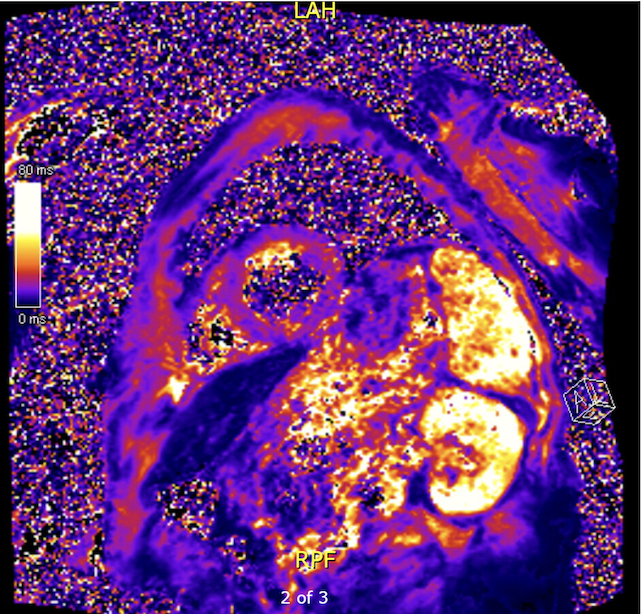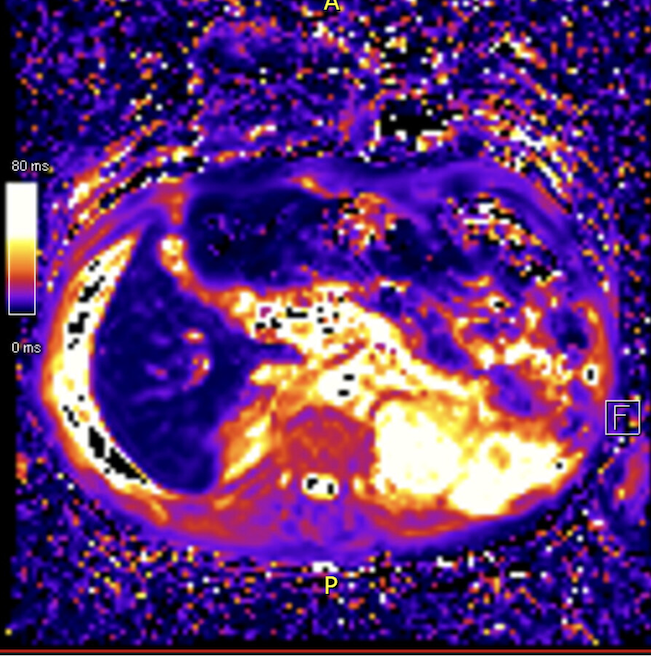Monday Poster Session
Category: Liver
P3955 - Hereditary Hemochromatosis Presenting With Cirrhosis and Cardiomyopathy
Monday, October 27, 2025
10:30 AM - 4:00 PM PDT
Location: Exhibit Hall

M Housam Nanah, MD
Cleveland Clinic
Cleveland, OH
Presenting Author(s)
M Housam Nanah, MD1, Tesfaye Yadete, MD2, Abdullah Hafeez, MD3, Jamile Wakim-Fleming, MD1
1Cleveland Clinic, Cleveland, OH; 2Cleveland Clinic Foundation, Cleveland, OH; 3Landmark Medical Center, Woonsocket, RI
Introduction: Hereditary hemochromatosis (HH) is an autosomal recessive disorder caused by mutations in the HFE gene, leading to decreased hepcidin and excessive iron absorption. Iron accumulation primarily affects the liver, causing cirrhosis and increasing the risk of hepatocellular carcinoma. Iron can also deposit in the pancreas and heart, leading to diabetes and cardiomyopathy. Early detection and phlebotomy can prevent complications, but delayed diagnosis may result in irreversible organ damage. We present a case of HH manifesting as decompensated cirrhosis and cardiomyopathy, prompting evaluation for combined heart-liver transplantation.
Case Description/
Methods: A 63-year-old male with known HH and decompensated cirrhosis was referred for transplant evaluation. His MELD-Na was 25. Cirrhosis was complicated by hepatic encephalopathy, ascites, spontaneous bacterial peritonitis, esophageal varices, and recurrent hepatic hydrothorax requiring VATS pleurodesis. He experienced episodes of congestive heart failure. Echocardiogram showed an EF of 40%, mildly dilated LV with mild concentric hypertrophy, mild global hypokinesis, and a mildly dilated RV with preserved function. MRI with T2 mapping study revealed mild myocardial iron overload, evidenced by mid-ventricular slice relaxation time of 15(+/- 1.02) ms, severe hepatic (T2 of 4 +/- 0.51 ms with estimated iron concentration of 6.5 mg/g), and pancreatic iron overload.
He initially underwent phlebotomy but developed anemia. Chelation therapy was initiated to reduce iron burden, especially in cardiac tissue. He required dual chelation with oral deferasirox and subcutaneous deferoxamine.
Discussion: HH is one of the most common inherited metabolic diseases in individuals of Northern European descent, with a genetic prevalence of 1 in 200–400. Despite this, clinical penetrance is low. When untreated, HH can cause severe complications, including cirrhosis, hepatocellular carcinoma, diabetes, and cardiomyopathy. Cardiac involvement, though less frequent, significantly worsens prognosis and contributes to mortality. Liver transplantation is rare in HH, and combined liver-heart transplantation is extremely uncommon. This case presents a delayed HH diagnosis with irreversible multiorgan damage. While most literature focuses on early-stage HH, few address progression to dual-organ failure. This case highlights the importance of early detection, iron monitoring, and multidisciplinary transplant assessment, and serves as a cautionary example of delayed recognition.

Figure: T2 mapping MRI demonstrating iron deposition in the heart

Figure: T2 mapping MRI demonstrating iron deposition in the liver
Disclosures:
M Housam Nanah indicated no relevant financial relationships.
Tesfaye Yadete indicated no relevant financial relationships.
Abdullah Hafeez indicated no relevant financial relationships.
Jamile Wakim-Fleming indicated no relevant financial relationships.
M Housam Nanah, MD1, Tesfaye Yadete, MD2, Abdullah Hafeez, MD3, Jamile Wakim-Fleming, MD1. P3955 - Hereditary Hemochromatosis Presenting With Cirrhosis and Cardiomyopathy, ACG 2025 Annual Scientific Meeting Abstracts. Phoenix, AZ: American College of Gastroenterology.
1Cleveland Clinic, Cleveland, OH; 2Cleveland Clinic Foundation, Cleveland, OH; 3Landmark Medical Center, Woonsocket, RI
Introduction: Hereditary hemochromatosis (HH) is an autosomal recessive disorder caused by mutations in the HFE gene, leading to decreased hepcidin and excessive iron absorption. Iron accumulation primarily affects the liver, causing cirrhosis and increasing the risk of hepatocellular carcinoma. Iron can also deposit in the pancreas and heart, leading to diabetes and cardiomyopathy. Early detection and phlebotomy can prevent complications, but delayed diagnosis may result in irreversible organ damage. We present a case of HH manifesting as decompensated cirrhosis and cardiomyopathy, prompting evaluation for combined heart-liver transplantation.
Case Description/
Methods: A 63-year-old male with known HH and decompensated cirrhosis was referred for transplant evaluation. His MELD-Na was 25. Cirrhosis was complicated by hepatic encephalopathy, ascites, spontaneous bacterial peritonitis, esophageal varices, and recurrent hepatic hydrothorax requiring VATS pleurodesis. He experienced episodes of congestive heart failure. Echocardiogram showed an EF of 40%, mildly dilated LV with mild concentric hypertrophy, mild global hypokinesis, and a mildly dilated RV with preserved function. MRI with T2 mapping study revealed mild myocardial iron overload, evidenced by mid-ventricular slice relaxation time of 15(+/- 1.02) ms, severe hepatic (T2 of 4 +/- 0.51 ms with estimated iron concentration of 6.5 mg/g), and pancreatic iron overload.
He initially underwent phlebotomy but developed anemia. Chelation therapy was initiated to reduce iron burden, especially in cardiac tissue. He required dual chelation with oral deferasirox and subcutaneous deferoxamine.
Discussion: HH is one of the most common inherited metabolic diseases in individuals of Northern European descent, with a genetic prevalence of 1 in 200–400. Despite this, clinical penetrance is low. When untreated, HH can cause severe complications, including cirrhosis, hepatocellular carcinoma, diabetes, and cardiomyopathy. Cardiac involvement, though less frequent, significantly worsens prognosis and contributes to mortality. Liver transplantation is rare in HH, and combined liver-heart transplantation is extremely uncommon. This case presents a delayed HH diagnosis with irreversible multiorgan damage. While most literature focuses on early-stage HH, few address progression to dual-organ failure. This case highlights the importance of early detection, iron monitoring, and multidisciplinary transplant assessment, and serves as a cautionary example of delayed recognition.

Figure: T2 mapping MRI demonstrating iron deposition in the heart

Figure: T2 mapping MRI demonstrating iron deposition in the liver
Disclosures:
M Housam Nanah indicated no relevant financial relationships.
Tesfaye Yadete indicated no relevant financial relationships.
Abdullah Hafeez indicated no relevant financial relationships.
Jamile Wakim-Fleming indicated no relevant financial relationships.
M Housam Nanah, MD1, Tesfaye Yadete, MD2, Abdullah Hafeez, MD3, Jamile Wakim-Fleming, MD1. P3955 - Hereditary Hemochromatosis Presenting With Cirrhosis and Cardiomyopathy, ACG 2025 Annual Scientific Meeting Abstracts. Phoenix, AZ: American College of Gastroenterology.
